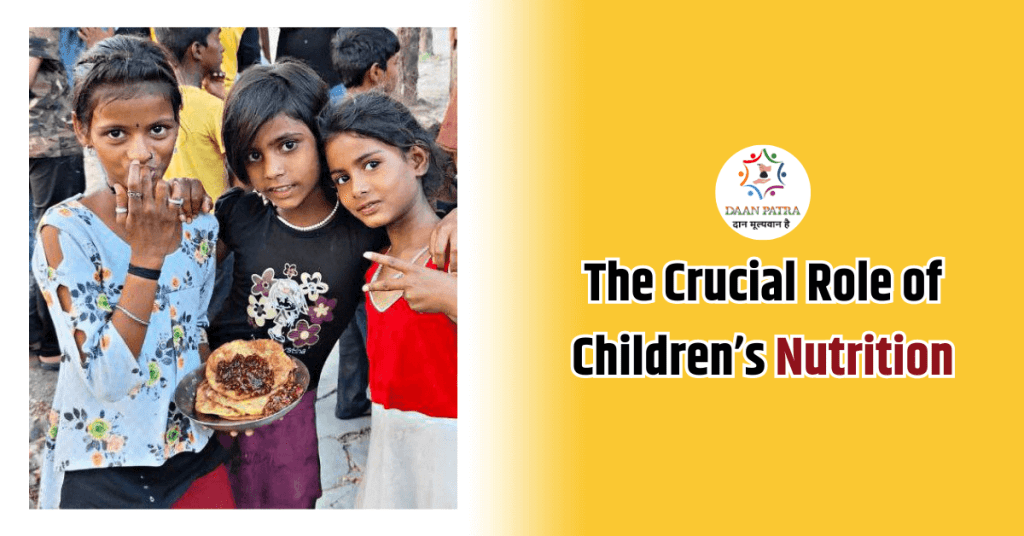Children’s nutrition plays a vital and irreplaceable role in shaping their present well-being and future potential. Much like the foundation of a sturdy building, proper nutrition establishes the groundwork for robust growth, both physically and cognitively. The nutrients children receive in their formative years act as the building blocks for strong bones, organs, and a resilient immune system. Consider it as an investment in their future; the nutrients absorbed today lay the groundwork for a resilient, healthy adulthood. Beyond the prevention of immediate health issues, proper nutrition acts as a safeguard against the rising tide of chronic diseases, offering a gift that keeps on giving throughout their lives. Keep going with the article if want to know more about Importance of Children Nutrition.
In essence, children’s nutrition is a symphony of elements, each note contributing to the masterpiece of their growth and potential. It is not merely about meeting basic dietary needs; it is about sculpting a robust foundation that empowers them to face the world with strength, vigor, and the promise of a flourishing future.
Importance of Children Nutrition
- Growth and Development: Picture a garden; nutrition is the sunlight and soil nurturing the delicate seed of a child’s potential, ensuring it sprouts into the full bloom of physical development.
- Cognitive Function: Nutrition is the fuel for the intricate machinery of the brain. It provides the essential elements needed for neurons to connect, synapses to fire, and intelligence to blossom.
- Immune System Support: Think of a fortress; proper nutrition builds the walls, arming a child against the onslaught of infections and diseases. It is the shield that wards off illness, allowing them to explore the world without fear.
- Energy Levels: Imagine a power source; nutrition is the generator powering a child’s ceaseless activities, from playtime to learning endeavors, ensuring they have the energy to conquer each day.
- Prevention of Health Issues: Nutrition acts as a guardian, preventing the emergence of health issues like obesity, diabetes, and cardiovascular diseases, laying the groundwork for a resilient and robust future.
Child Health and Nutrition
Children’s health is not a separate entity but is intricately linked to their nutritional status. A balanced diet for a child encompasses:
- Fruits and Vegetables: These are the vibrant hues on the palette, rich in vitamins, minerals, and antioxidants, essential for the creation of a healthy life canvas.
- Proteins: The architects of growth and repair, proteins sourced from meat, poultry, fish, eggs, beans, and nuts construct the foundation of a strong and resilient body.
- Whole Grains: These are the bricks, that provide energy and a myriad of important nutrients, fortifying the structure of a child’s health.
- Dairy or Alternatives: Essential for the scaffolding of bones, providing calcium and vitamin D, crucial for the framework of growth.
- Fats: Healthy fats, akin to the artist’s brushstrokes, contribute to brain development, found in avocados, nuts, and olive oil.
Nutritional Requirements for Children
Understanding that each child is a unique masterpiece, their nutritional needs vary based on factors such as age, sex, and activity level. General guidelines encompass:
- Caloric Intake: A tailored measure, adjusting for age and activity level, ensuring the child’s energy needs are met.
- Protein: Tailored to the child’s age, ensuring sufficient intake for growth and repair.
- Vitamins and Minerals: A delicate balance, ensuring an ample supply of vitamins A, C, D, calcium, and iron for various bodily functions.
- Hydration: Often underestimated, the lifeblood of proper nutrition, ensuring children understand the importance of staying adequately hydrated.
Children’s Food and Nutrition Guidelines
Guidelines provided by esteemed organizations, particularly the WHO, serve as a roadmap for caregivers and parents to navigate the intricate landscape of children’s nutrition. The WHO advocates for:
- Exclusive Breastfeeding: The first six months of life, a nurturing foundation that sets the tone for lifelong health.
- Diverse Diet: A palette of diverse foods, ensuring a broad spectrum of nutrients, flavors, and textures to fuel the body’s artistic journey.
- Limiting Sugar and Salt Intake: A brushstroke of caution, preventing the creation of unhealthy habits and preserving the purity of a child’s nutritional canvas.
- Educating Caregivers: The empowering knowledge that equips parents and caregivers to make informed choices, fostering an environment of nutritional excellence.
Purpose of Child Nutrition
Beyond the mere act of sustenance, the purpose of nutrition in children is to craft a masterpiece of health, resilience, and limitless potential. The key purposes unfold as:
- Promoting Lifelong Health: The brushstrokes of good nutritional habits in early life contribute to a canvas of enduring health and well-being.
- Optimizing Cognitive Potential: The symphony of nutrients orchestrates the melody of intelligence, ensuring the brain’s harmonious development.
- Preventing Malnutrition: The vigilant guardian against both undernutrition and overnutrition, preserving the delicate balance necessary for a child’s flourishing.
- Building Resilience: The armor against the battles of infections and illnesses, empowering children to face the world with strength and vitality.
FAQs:
- What defines child nutrition?
Child nutrition is the art and science of providing essential nutrients that foster the growth, development, and maintenance of a child’s body, including proteins, carbohydrates, fats, vitamins, and minerals.
- Why is child nutrition important?
Child nutrition is the cornerstone of a child’s growth, cognitive function, immune system support, energy levels, and the prevention of health issues such as obesity and chronic diseases.
- WHO guidelines for child nutrition?
The World Health Organization emphasizes exclusive breastfeeding for the first six months, introducing diverse complementary foods, limiting sugar and salt intake, and educating caregivers on proper nutrition.
Conclusion
In conclusion, the role of children’s nutrition transcends the routine act of providing meals; it is a profound investment in the holistic development of a generation. It’s akin to laying the bricks for a sturdy fortress, fortifying them against the challenges of both the present and the future. The nutritional choices made during childhood echo through the corridors of time, influencing not only physical health but also shaping character, resilience, and the ability to navigate life’s complexities.
Imagine nutrition as the artist’s palette, with each nutrient contributing a vibrant hue to the canvas of a child’s well-being. The complexities of this nutritional symphony are more than just the sum of their parts; they are the soundtrack of potential, echoing through the years.
Moreover, the dividends of proper nutrition go beyond the individual child. A generation raised on the principles of balanced nutrition becomes a collective force, a society fortified against the burdens of healthcare, a populace equipped to face global challenges. The impact is not just personal but ripples through communities and societies, contributing to a healthier, more productive, and resilient world.
Therefore, let us view children’s nutrition not merely as a daily chore but as a collective responsibility to nurture the roots of a thriving, capable, and promising future. In each carefully crafted meal lies the promise of a healthier tomorrow, where every child can reach their full potential, contributing their unique brilliance to the tapestry of humanity.
Donate Online to Help Unprivileged Children
Make a meaningful impact by donating online to support underprivileged children. Your contribution can create opportunities, provide education, and bring hope for a brighter future
Related Posts:
- 10 Child Rights in India- A Comprehensive Guide
- What is the Purpose of education and Why It is Important?
- Child Education NGO in Jabalpur
- Child Education NGO in Dewas
- What is Child Centered Education and Why It’s Important


I have a great command of sophisticated language and literature because I am an artist at heart as well as a writer by profession. I am able to constantly produce work of a high quality because of my knowledge. I’m well-known for my versatility and am an excellent writer of both creative and technical content. To write content that is both entertaining and customized, I take the approach of getting to know the interests and preferences of my targeted audience.

